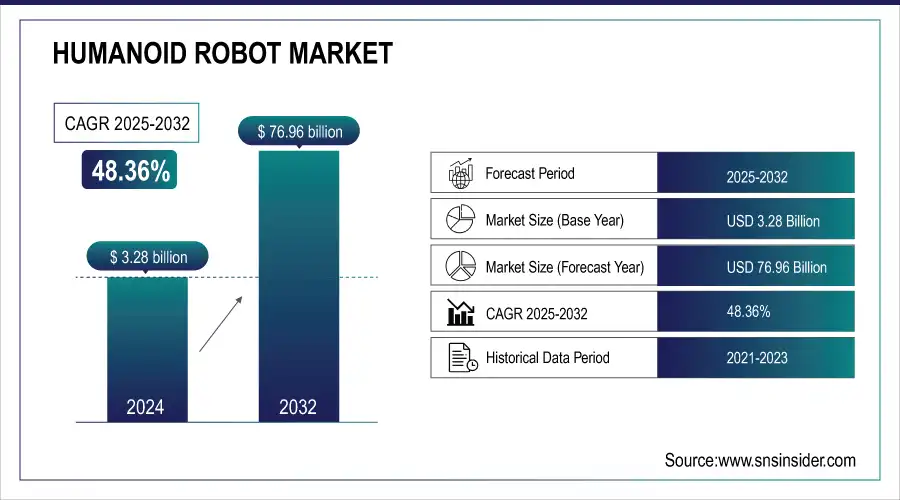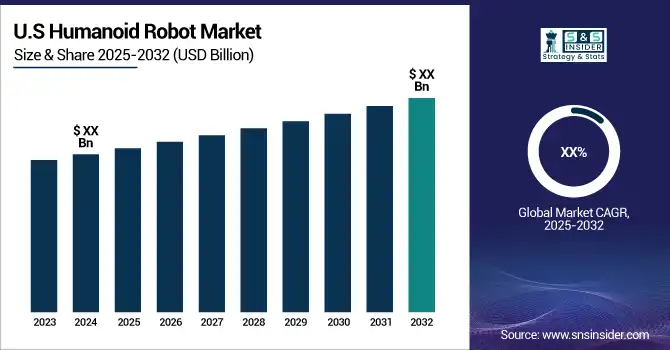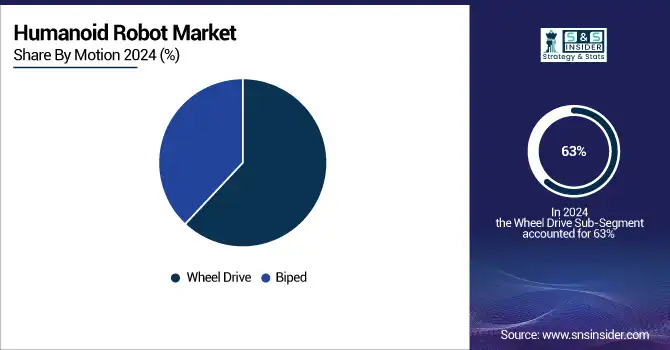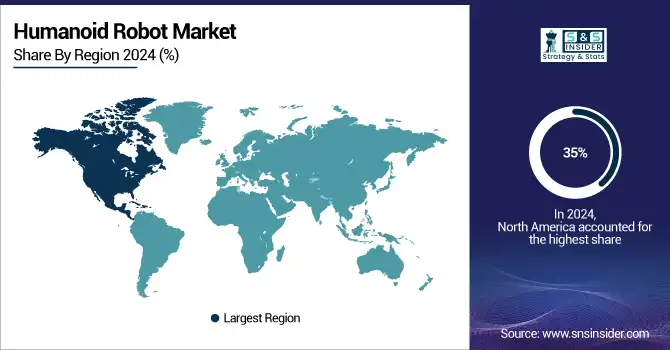Humanoid Robot Market Report Scope and Overview:
The Humanoid Robot Market Size was valued at USD 3.28 Billion in 2024 and is expected to reach USD 76.96 Billion by 2032 and grow at a CAGR of 48.36% over the forecast period 2025-2032.
The Humanoid Robot Market is witnessing transformative growth as there are technological advancements and the supportive policies of all these key nations. In 2023 and 2024, humanoid robots have moved from experimental prototypes to pragmatic solutions in industries ranging from healthcare to manufacturing.

Get more information on Humanoid Robot Market - Request Sample Report
Governments of such countries as Japan and China play a vital role in the market by providing large sums of funding and other strategic initiatives. Japan, known for its aging population, has used government-backed programs to deploy elder care robots. China's "Made in China 2025" strategy has focused on robotics to enhance industrial automation. The USA has invested significantly in robotics for defense and healthcare applications, with agencies such as DARPA fostering innovation.
Technological developments in AI, machine learning, and sensor technologies have significantly improved the functionalities of humanoid robots. Now, these robots have much better adaptability, mobility, and interactive features. For instance, Tesla's Optimus robot was unveiled in 2023. It stands at 5'8", weighing 125-160 lbs, with 28 actuators to mimic human movement. The robot is great at tasks such as manufacturing, logistics, and household tasks because it boasts 11-22 degrees of hand dexterity, eight cameras, and AI learning. On the other hand, India unveiled the Vyommitra robot, showing its use in space exploration. France and Germany also have developed their industrial humanoid robotics integrated with advanced systems to make efficiency and productivity in manufacturing possible.

Humanoid Robot Market Highlights:
-
Global humanoid robot installations increased by 25% in 2023 with continued growth expected in 2024 driven by AI and robotics advancements
-
Aging populations in countries like Japan and Germany are accelerating humanoid robot adoption to fill workforce gaps in manufacturing and logistics
-
Humanoid robots are increasingly used in elder care, rehabilitation, and patient monitoring improving efficiency and service quality in healthcare facilities
-
AI-driven vision systems, adaptive learning algorithms, and precision mechanics enhance the functionality and versatility of humanoid robots
-
Development, deployment, and maintenance of humanoid robots involve substantial investment limiting accessibility for small and mid-sized enterprises
-
Lack of standardized regulations and limited financial support for smaller businesses hinder widespread adoption emphasizing the need for collaborative industry and government initiatives
The future of the Humanoid Robot Market holds an enormous prospect in the areas of elder care, disaster management, and logistics. These robots have become the vital answer to the global labor shortages and increased demand for automation. In 2023, humanoid robot installations increased by 25% worldwide, and the growth is going to continue in 2024 as well, according to the World Robotics Report. Humanoid robots will certainly become a part of vital technology in many industries as advanced AI and robotics technologies are implemented.
Humanoid Robot Market Drivers:
-
Labor Shortages Are Pushing Industries To Adopt Humanoid Robots Globally.
There is an increasing labor shortage in countries like Japan and Germany, which have over 28% of its population over 65 years, creating a serious gap in workforce. Humanoid robots will help fill such gaps in terms of work done that were originally by humans from assembling parts on the factory floor to logistics management. The International Federation of Robotics has stated that industrial robot installations grew worldwide in 2023. With the rising workforce shortages, governments and companies are becoming increasingly urged to invest in robotic automation to ensure continuity of operations. This trend makes humanoid robots an integral part of the modern industrial ecosystem.
-
Growing Need For Healthcare Support Boosts Humanoid Robot Adoption Worldwide.
The healthcare sector is under pressure due to aging populations worldwide. Humanoid robots are gaining traction in elder care, rehabilitation, and patient monitoring. In Japan, robots like Robear are utilized in caregiving to assist elderly individuals with mobility and daily tasks. Similarly, a 2023 study by WHO highlights that 35% of elderly care facilities globally expressed interest in adopting robotics within the next five years. These robots automate routine tasks such that healthcare professionals can focus on critical care, thus enhancing service delivery and patient outcomes overall.
Humanoid Robot Market Restraints:
-
High Development Costs for the Adoption of Humanoid Robots by Different Sectors.
The development and deployment of humanoid robots require huge investments in the hardware, software, and R&D. Advanced technologies such as AI-driven vision systems, precision mechanics, and adaptive learning algorithms have a high cost of manufacture and integration. For example, highly advanced humanoid robots, Boston Dynamics' Atlas, cost at least USD 150,000, making it inaccessible for small to mid-sized firms. Additionally, maintenance and updates come with recurring expenses, further discouraging users.
Research in 2023 revealed that more than 45% of the small-scale manufacturers in Europe have reported financial constraints as a main reason for not adopting robotics. Although governments and private organizations provide grants, most of the funds go to large-scale corporations, which leave smaller businesses underserved. The lack of standardized regulations on humanoid robots also complicates the cost-to-benefit evaluation for potential adopters. Addressing these challenges will require collaborative efforts from governments, industries, and technology providers to ensure affordability and accessibility for all market participants.
Humanoid Robot Market Segment Analysis:
By Motion
The Wheel Drive segment led in 2024 with a 63% market share due to its operational stability and lower cost compared to biped robots. Wheel-driven humanoids are heavily used in logistics, retail, and healthcare for their ability to navigate flat terrains effectively. For instance, robots such as Pepper and Relay are highly deployed for customer interaction and delivery tasks.
Looking ahead, the wheel drive segment is forecasted to grow at the fastest CAGR of 48.49% from the years 2025-2032. This would mainly be due to wheel-based navigation systems that advance as well as humanoid robots get increasingly adopted in the sectors of service-oriented industries. They face limitations on uneven terrains, but cost-effective as well as versatile, this remains a preferred choice of varied applications.

By Application
Service segment led the Humanoid Robot Market, accounting for 48% of market share in 2024 due to wide usage in customer assistance, hospitality, and healthcare. Some popular service robots are SoftBank Robotics' Pepper, gaining popularity with interactive capabilities and efficient execution of repetitive tasks.
The industrial segment is expected to grow with the fastest CAGR of 49.09% from 2025 to 2032. More and more industries are opting for humanoid robots to perform welding, assembly, and quality control, among others. For example, companies like FANUC and ABB are incorporating humanoid robots in their production lines to maximize productivity and minimize labor costs. The growing need for automation in manufacturing and logistics would drive substantial growth in the industrial segment, complementing the dominance of service robots.
Humanoid Robot Market Reginal Analysis:
North America Humanoid Robot Market Trends:
In 2024, North America dominated the Humanoid Robot Market share by 35%, driven by technological advancements, high adoption rates in healthcare and logistics, and robust government support. USA has led the region with substantial investments in robotics for healthcare and defense.

Get Customized Report as per your Business Requirement - Request For Customized Report
Asia-Pacific Humanoid Robot Market Trends:
Asia Pacific is expected to grow the fastest with a CAGR of 49.65% in the period from 2025 to 2032. Japan and China are leading the country in robotics innovation with more government support and strong base manufacturing. Elder care robot leadership in Japan and the industrial automation initiatives in China show prospects for growth in this region. 70% of all new robots deployed in 2023 were installed in Asia. China holds the top spot for installing industrial robots with 51% of the installations.
Europe Humanoid Robot Market Trends:
Europe held a moderate share of the humanoid robot market in 2023, supported by strong investments in research and development, healthcare robotics, and collaborative robots in manufacturing. Germany, France, and the UK are leading countries in industrial and service robot deployment. The EU’s focus on automation and smart manufacturing initiatives is expected to drive steady growth between 2024 and 2032.
Latin America Humanoid Robot Market Trends:
Latin America is a developing market for humanoid robots, with gradual adoption in manufacturing, healthcare, and education sectors. Brazil and Mexico are leading in deployments, supported by industrial automation programs and robotics education initiatives. Market growth is projected at a moderate CAGR due to increasing industrial investments and rising interest in service robots from 2024 to 2032.
Middle East & Africa Humanoid Robot Market Trends:
The Middle East & Africa region is witnessing gradual adoption of humanoid robots, primarily in defense, security, and logistics sectors. Countries like the UAE and Saudi Arabia are investing in smart city projects, AI integration, and robotics for public services. Market growth is expected to accelerate with increasing awareness and government-led innovation initiatives.
Humanoid Robot Market Key Players:
-
Boston Dynamics (Atlas, Spot)
-
Honda Robotics (ASIMO, E2-DR)
-
SoftBank Robotics (Pepper, NAO)
-
UBTECH Robotics (Walker, Alpha Mini)
-
Agility Robotics (Digit, Cassie)
-
Tesla (Optimus, AI-driven systems)
-
Toyota Research Institute (T-HR3, Partner Robots)
-
Hanson Robotics (Sophia, Little Sophia)
-
PAL Robotics (REEM, TIAGo)
-
RoboKind (Milo, Robots4Autism)
-
Kawada Robotics (NEXTAGE, HRP series)
-
Samsung Electronics (Bot Handy, Bot Care)
-
ABB (YuMi, GoFa)
-
Shadow Robot Company (Dexterous Hand, Manipulation Systems)
-
Festo (BionicCobot, BionicSoftHand)
-
Hyundai Robotics (EXOS, Humanoid Service Robots)
-
iRobot (Roomba AI systems, Ava Robotics)
-
Boston Micro Fabrication (Micro-manipulators, 3D Printed Components)
-
Rethink Robotics (Sawyer, Baxter)
-
Mitsubishi Electric (MELFA, Humanoid Service Robots)
MAJOR SUPPLIERS (Components, Technologies)
-
NVIDIA (AI processors, GPUs)
-
Intel (CPUs, Edge Computing Chips)
-
Qualcomm (Snapdragon Robotics Platforms, AI Engines)
-
Texas Instruments (Microcontrollers, Power Management ICs)
-
Harmonic Drive (Precision Gears, Actuators)
-
Maxon Motors (Electric Motors, Actuator Systems)
-
TE Connectivity (Sensors, Connectors)
-
Panasonic (Batteries, Electronic Components)
-
LG Chem (Battery Cells, Energy Storage)
-
Bosch (Sensors, Embedded Systems)
-
Onsemi (Semiconductors, Power Electronics)
-
TDK Corporation (Capacitors, Inductors)
-
Renesas Electronics (Microcontrollers, SoCs)
-
Analog Devices (Sensors, Signal Processing ICs)
-
STMicroelectronics (MCUs, Sensors)
-
Schunk (Grippers, Robotic Accessories)
-
Honeywell (Sensors, Safety Components)
-
Fanuc (Robotic Components, Automation Systems)
-
Mouser Electronics (Electronic Components, Modules)
-
Yaskawa Electric (Servo Motors, Robotic Systems)
Humanoid Robot Market Competitive Landscape:
Agility Robotics is a U.S.-based robotics company specializing in bipedal robots designed for mobility, logistics, and industrial applications. Their flagship robot, Digit, combines advanced sensors, AI, and dynamic movement capabilities to navigate complex environments. The company focuses on enhancing automation, safety, and efficiency across various industries worldwide.
-
November 2024: Agility Robotics, creator of the leading bipedal Mobile Manipulation Robot (MMR) DigitⓇ, today announced during an appearance at global technology conference Web Summit that Schaeffler has made a minority investment in the company. In addition to the investment, the companies have signed an agreement in which Schaeffler, the motion technology company, intends to purchase humanoid robots from Agility Robotics for use across the whole global Schaeffler plant network.
Boston Dynamics is a leading robotics company known for advanced mobile robots like Spot and Atlas, combining AI, sensors, and dynamic movement to perform complex tasks. The company focuses on robotics solutions for logistics, inspection, and research, enhancing automation, safety, and operational efficiency across industries globally.
Toyota Research is Toyota’s R&D division driving innovation in robotics, mobility, and AI technologies. It focuses on developing humanoid robots, automated vehicles, and assistive technologies to improve human mobility, safety, and quality of life. The division emphasizes sustainability, cutting-edge research, and practical applications in transportation and everyday life.
-
October 2024: Boston Dynamics and the Toyota Research Institute have just announced a strategic partnership with a shared focus: to expedite development on general-purpose humanoid robots. TRI is using the state-of-the-art Large Behaviour Models while Boston Dynamics utilizes its legendary Atlas robot. The alliance has huge possibilities for creating a paradigm shift in the development of artificial intelligence and robotics.
| Report Attributes | Details |
|---|---|
| Market Size in 2024 | USD 2.21 Billion |
| Market Size by 2032 | USD 76.97 Billion |
| CAGR | CAGR of 48.36 % From 2025 to 2032 |
| Base Year | 2024 |
| Forecast Period | 2025-2032 |
| Historical Data | 2020-2022 |
| Report Scope & Coverage | Market Size, Segments Analysis, Competitive Landscape, Regional Analysis, DROC & SWOT Analysis, Forecast Outlook |
| Key Segments | • By Motion (Biped, Wheel Drive), • By Component (Hardware, Software), • By Application (Industrial, Household, and Services), • By End Use (Education and Entertainment, Research and Space Exploration, Personal Assistance and Caregiving, Search and Rescue, Public Relations, Others) |
| Regional Analysis/Coverage | North America (US, Canada, Mexico), Europe (Eastern Europe [Poland, Romania, Hungary, Turkey, Rest of Eastern Europe] Western Europe] Germany, France, UK, Italy, Spain, Netherlands, Switzerland, Austria, Rest of Western Europe]), Asia Pacific (China, India, Japan, South Korea, Vietnam, Singapore, Australia, Rest of Asia Pacific), Middle East & Africa (Middle East [UAE, Egypt, Saudi Arabia, Qatar, Rest of Middle East], Africa [Nigeria, South Africa, Rest of Africa], Latin America (Brazil, Argentina, Colombia, Rest of Latin America) |
| Company Profiles | Boston Dynamics, Honda Robotics, SoftBank Robotics, UBTECH Robotics, Agility Robotics, Tesla, Toyota Research Institute, Hanson Robotics, PAL Robotics, RoboKind, Kawada Robotics, Samsung Electronics, ABB, Shadow Robot Company, Festo, Hyundai Robotics, iRobot, Boston Micro Fabrication, Rethink Robotics, Mitsubishi Electric. |

